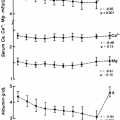EMBRYOLOGY
The adrenal cortex and medulla arise from separate embryologic tissues (Fig. 71-1). Beginning in the fourth week of gestation, cells destined to form the adrenal cortex develop from primitive mesoderm just medial to the urogenital ridge. These cells penetrate the overlying retroperitoneal mesenchyme and, over the next several weeks, form a gradually enlarging adrenal cortex. During the sixth week of gestation, the developing cortex is penetrated by nerve fibers, along which primitive medullary cells will eventually migrate. By the eighth week, the cortex has formed two distinct zones: a relatively large and centrally located fetal zone and a thin rim of definitive cortex, which will later form the adult adrenal cortex. Throughout this period, proliferation is largely confined to the outer definitive cortex, suggesting that the same cells give rise to both the fetal and definitive zones. About this time, the fetal adrenal circulation is established, with several adrenal arteries arising from the descending aorta, and a central vein draining each adrenal gland. Between the second and third month of gestation, the adrenal glands increase in weight from about 5 to 80 mg, are much larger than the adjacent kidney, and reach their greatest size relative to total fetal weight. Growth of the adrenal cortex after the 20th week of gestation is dependent on pituitary stimulation (anencephalic fetuses are born with an atrophic adrenal fetal zone). After birth, the fetal zone involutes and the definitive cortex evolves into the three zones of the adult adrenal cortex (Fig. 71-2).
Stay updated, free articles. Join our Telegram channel

Full access? Get Clinical Tree





